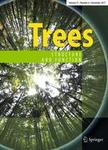版权所有:内蒙古大学图书馆 技术提供:维普资讯• 智图
内蒙古自治区呼和浩特市赛罕区大学西街235号 邮编: 010021

作者机构:Univ Nat Resources & Life Sci Dept Integrat Biol Inst Bot BOKU Vienna A-1180 Vienna Austria Forestry Res Inst Sweden Skogforsk S-26890 Svalov Sweden
出 版 物:《TREES-STRUCTURE AND FUNCTION》 (树木;结构和机能)
年 卷 期:2011年第25卷第2期
页 面:289-299页
核心收录:
学科分类:0710[理学-生物学] 071001[理学-植物学] 0907[农学-林学] 07[理学]
基 金:Austrian Science Fund (FWF) [T304-B16 V146-B16]
主 题:Compression strength perpendicular to the grain Conduit wall reinforcement Hydraulic efficiency Modulus of elasticity in bending Norway spruce Structure-function relationships Vulnerability to cavitation Wood shrinkage
摘 要:The aim of this study was to investigate bending stiffness and compression strength perpendicular to the grain of Norway spruce (Picea abies (L.) Karst.) trunkwood with different anatomical and hydraulic properties. Hydraulically less safe mature sapwood had bigger hydraulic lumen diameters and higher specific hydraulic conductivities than hydraulically safer juvenile wood. Bending stiffness (MOE) was higher, whereas radial compression strength lower in mature than in juvenile wood. A density-based tradeoff between MOE and hydraulic efficiency was apparent in mature wood only. Across cambial age, bending stiffness did not compromise hydraulic efficiency due to variation in latewood percent and because of the structural demands of the tree top (e.g. high flexibility). Radial compression strength compromised, however, hydraulic efficiency because it was extremely dependent on the characteristics of the weakest wood part, the highly conductive earlywood. An increase in conduit wall reinforcement of earlywood tracheids would be too costly for the tree. Increasing radial compression strength by modification of microfibril angles or ray cell number could result in a decrease of MOE, which would negatively affect the trunk s capability to support the crown. We propose that radial compression strength could be an easily assessable and highly predictive parameter for the resistance against implosion or vulnerability to cavitation across conifer species, which should be topic of further studies.